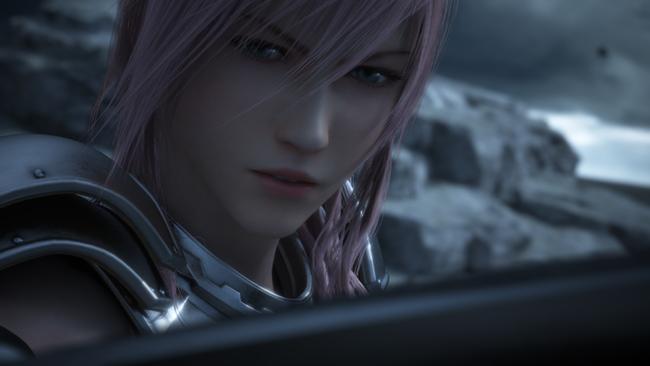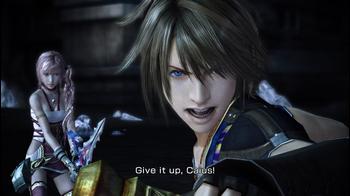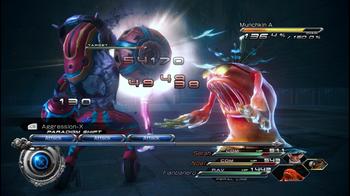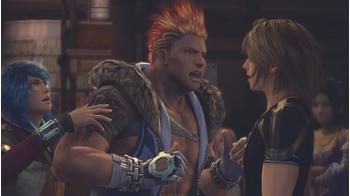Final Fantasy XIII-2 Yoshinori Kitase Interview
The lovely folks at Square Enix Europe were kind enough to give us the chance to sit down with Final Fantasy XIII-2 Producer Yoshinori Kitase earlier this month to talk about the latest developments in the continuing adventures of Lighting and Serah.
We bend his ear regarding everything from character ages to development time and how Tetsuya Nomura's artwork has come to embody the main-line Final Fantasy series. A lot of these questions are from readers over Twitter and other communications channels, so be sure to keep an eye out for further chances to pitch your questions to the producers of games you're interested in!
We'll have a fresh hands-on with Final Fantasy XIII-2 looking at a large chunk of the game from the opening until several hours in next week, but in the meantime remember to hit up the Final Fantasy XIII-2 game page for our previous Previews and Interviews and the Media Vault for Screenshots, Videos and Artwork from the game.

RPG Site: First up, some people in the community have expressed an interest in the playable characters in the game. Final Fantasy has always had younger lead characters, and notably with Final Fantasy XII they had an older lead for a while in Basch and then switched him out for the younger Vaan. In XIII-2 you've Serah and Noel, who are both very young. Is the choice of character age a deliberate thing to attract certain kinds of customers?
Yoshinori Kitase: The young playable characters are not something we did on purpose, really. What we had, to start with - Serah was one of the characters from XIII and in the story of XIII Serah becomes crystallized and her sister, Lightning, has to go through all the adventures to find a way to rescue her or bring her back to life. We wanted to tell the story in the reverse situation in XIII-2. At the beginning Lightning is missing, so Serah has to look for her - that was the bottom line to start with.
Then we thought about maybe we should add a party with some Monsters and a Moogle. When we visualized Serah as the protagonist and the Moogle and the Monster, that'd be a little bit like X-2, for example - a story with three girls. X-2 was criticized by some people for being too poppy and too cheerful and too casual, too light hearted. Because Serah - unlike Lightning, she's quite a cute girly character, just combined with the monsters it'd be a little bit too - too sort of - not really serious enough.
Because XIII has quite a serious air to it, we wanted to take that over into XIII-2. Plus we wanted to make XIII-2's story a little bit darker and more mysterious, so we thought a male character would perfect the kind of general air of the game. That's why we decided to include Noel.
RPG Site: You've got the focus now on visible equipment in cutscenes - so if you equip a weapon it'll show up in cutscenes. Final Fantasy is quite famed for its pre-rendered CGI sequences, though. Does this new focus on showing equipped weapons mean we'll see less CG in the game?
Kitase: Because we know we've got great platforms, we've got a high spec that we can utilize. We used to have to use lots of pre-rendered movies - that was the only option, really. Now we obviously have another option, the real time rendering. On the other hand, pre-rendered visuals, the technique has moved on at the same time that the real-time rendering has improved as well. It's a bit of a Catch 22 - you can't say one way is better than the other. They'll never be the same quality.
In some particular types of cutscenes, like if you can think of a huge group of people against another huge group of people on quite a big scale, for that particular type of visuals I think pre-rendered might actually be better. It's one of those things where we'll continue to use pre-rendered. It's not like pre-rendered movies will be wiped out from RPGs, but it is great that the equipment and costumes and things like that can be reflected on the characters in the cutscenes, and also you can enjoy some kind of interaction with the visuals. I think that those two things will cohabit in RPGs we'll be making.
RPG Site: Some of the costumes and weapons will be available as downloadable content. With Dissidia, some of the downloadable items were exclusive to certain territories or events and such. Will there be a way for people to obtain all DLC eventually, regardless of where it first appeared?
Kitase: Obviously, we've got to consider the needs of different regions. We also have got tie-ups which need to be finalized yet - so, yeah. At the moment, we don't know.
RPG Site: Will there be more than just monsters, costumes and items available for download?
Kitase: It's already been announced that there will be costumes available but also Omega, a monster. Because of the Monster recruitment system of the game once you've had a battle against Omega you can recruit it to be one of your party members. Other than that, after the release for several months we are planning to make different types of DLC available - not just monsters and costumes but other content as well. Unfortunately I can't give you any more details at the moment.
RPG Site: Final Fantasy XIII-2 is coming around a heck of a lot quicker than XIII did, but it is of course a sequel. Then you've got Versus which is taking quite a while - but it's crazy to think now that IV, V and VI all came out in the space of four years, and VII, VIII and IX came out in a mere three. Do you feel that age where you can kick out three all-original games in quick succession is gone, or are there lessons to be learned where you can speed up development again?
Kitase: You can't really talk about RPGs and FPS together - with some of the big name Western titles like Modern Warfare and Battlefield you can expect a new game in one year or two - a very quick turnaround. On the other hand, FPS the basics are already there - it's established, so you don't have to create everything from scratch. That's one of the reasons that they can make these games in such a quick turn-around.
When it comes to RPGs like Final Fantasy, obviously you have to make everything from scratch. As you say, Final Fantasy XIII-2 is a sequel to Final Fantasy XIII, so all the basics and technology was already there, so we only had to upgrade some aspects. If we wanted to make a numbered Final Fantasy title, you have to create a story, mechanics - everything. It's a painstaking process. In a way, it's inevitable that we take a little bit longer time.
RPG Site: I spoke to Mr. Yoshida about Final Fantasy XIV recently, and we talked about how open he's been since taking over the development of that game. XIV's having what I'd call an inclusive process, more directly involving fans in the process. Obviously that's an MMO and is different, but do you think there'd be a benefit to having a more open process with the fans for a single player game?
Kitase: Generally speaking I think it's a good idea to get all of the community involved, and we are definitely about that. On the other hand, you have to think of the natures of the different genres. MMO and 'boxed' titles are very different. For example, Final Fantasy XIV is an online game, and after the release it still has to keep evolving and taking in all sorts of ideas, and even if there's some mistakes or some areas that could be better, you can actually release a patch - there's a different way for the game to develop.
If it's a boxed title like Final Fantasy, once it's been released you can't really fix any problems - in a major way, anyway. What we did was this - we carried out user research sessions in all of the three regions periodically - we did it several times. We rounded up ordinary gamers rather than professional gamers, and they played a current build - it could've been Alpha version or whatever - and we collected their opinions and the pros and cons from these people. That reflected on the next build. In that way, the game could be - could represent - what ordinary gamers feel.
RPG Site: The main Final Fantasy series has been mainly defined by one particular art style since VII, spearheaded by Tetsuya Nomura. Even when Nomura hasn't been the lead character designer, like with XIII, he's had some input and the game has overall followed his style. Do you see that as 'the' style for the main-line series of Final Fantasy, meaning we'll see other styles in things like Crystal Chronicles and the MMOs but not in the main single-player series, which is now defined by that style?
Kitase: You mentioned VII - that mark, that new departure into the world of 3D graphics and the high spec platforms and all the rest. So now we've got a much better graphics engine which means we're able to draw very realistic environment; everything is getting more and more real. If somebody was to turn around and ask us 'Would you like to make the characters look like Live Action?' our basic answer is no, because we don't need to.
Those characters don't need to look that realistic. They already look almost like actual human beings. Our basic sort of style is that even though they look quite realistic they still should have some elements of animation, manga taste to it. It's a nice sort of marriage of these two aspects will be something we always aim for. In that sense, Nomura's direction is perfect.
Also, that's something that Nomura is aiming for anyway - that's the kind of visual concept that Final Fantasy should stay with. At the moment, that is something that we think is the best.
RPG Site: We're over-running, but we have one last quick yes-or-no question from a reader. Hiroyuki Itou held various major roles on the Final Fantasy series right back to the original game in 1987, but he hasn't been credited in a production role of a game since 2007's Final Fantasy IV DS. Is he still with the company?
Kitase: (In English) Yes.
RPG Site: Thank you very much for your time! Good luck with the Japanese launch.


